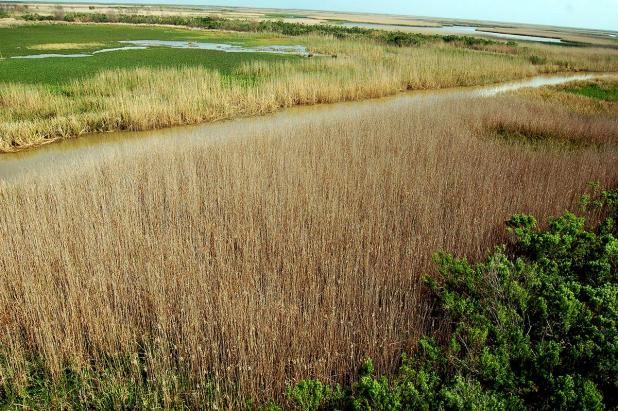
The Roseau Cane Mealy Bug can decimate a stand of it's namesake plant, a critical deterrent to coastal erosion. (Louisiana Dept. Wildlife & Fisheries photos)
Is an Asian insect the latest threat to La. coast?
By ANTHONY EMMONS
The Roseau Cane Mealy Bug poses a threat to coastal rebuilding efforts in Louisiana, according to Rodrigo Diaz, Assistant Professor of Entomology at LSU.
Diaz says this non-native species has been located extensively in Plaquemines Parish and is a threat to Roseau Cane.
“Roseau Cane is one of the best plants for preventing erosion as it has a strong root system,” Diaz reported to CPRA (the Coastal Protection Restoration Authority) at Wednesday’s meeting in Baton Rouge.
Diaz, who specializes in Invasive Species Ecology and Biology Control, said, “The insect is commonly referred to as Phragmites Scale or Roseau Cane Mealy Bug. It is native to China and Japan and has had severe effects on vegetation of the Mississippi River Delta, especially wetland grass that help protect our coastline against coastal erosion.”
No one knows how this insect, Nipponaclerda biwakoensis, has arrived on the shores of Louisiana, Rodriguez said, but research is ongoing.
Roseau cane grows well in deep water and currently there is no other indigenous plant which can help retard the wave erosion as well. This plant has proven critical in some regions of the state and especially in the building of barrier islands which depend on healthy vegetation. Roseau plants are part of the answer.
Louisiana state biologists have found that tiny scales, which are a result of the insect, are attacking various locations and most have been located in Plaquemines Parish. The insect has also been located at Lafitte and Grand Isle. Researchers have found that where there should have been rows and rows of Roseau cane, all that remains is open water with some patches of Roseau stems remaining.
Research is being conducted to determine if salinity is attributing to the deterioration of Roseau cane and it has been found that in depths of water of three feet or less, it appears to be affected more by the insect. The deterioration of the Roseau plants occurs rapidly and it only takes a few months and the scales are already on the regrowth.
Diaz noted that in one area it only took a month for the brownish scales to damage the area. The scales feed on sap of the plant and reduce plant reserves. Baby scales are tiny, the length of tip of a needle, and as they grow they form large colonies. Research is ongoing to attempt to identify if this insect will attack other plants which are essential to fighting the deterioration of our coastline, such as Wheat Grass and Rush.
Louisiana Department of Wildlife and Fisheries officials and the LSU AgCenter have warned residents and boaters not to transport or transplant Roseau cane into other parts of the state.
“Insecticides may solve the problem,” Diaz said, but he added that some insecticides may hurt speckled trout, redfish, oysters and shrimp and an insecticide plan should not be implemented until they can analyze the effect of the insecticide on these fisheries.
“We do know that healthy Roseau cane is essential to fighting coastal erosion,” he said.
